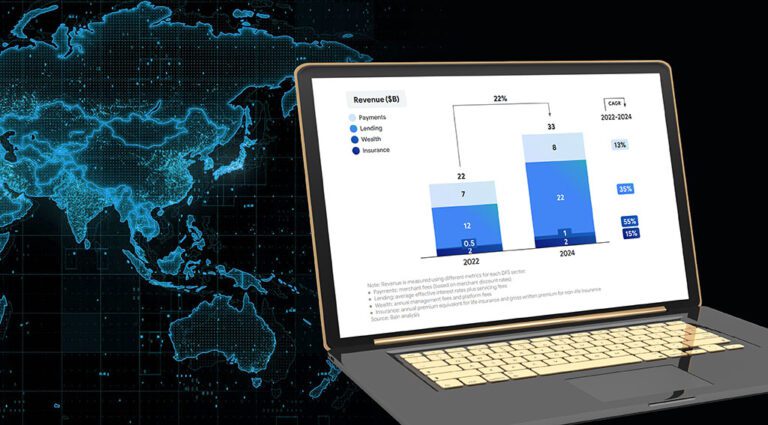Digital financial services (DFS) in Southeast Asia (SEA) are on a remarkable growth trajectory, with revenues projected to increase by 22%, from US$22 billion in 2022 to US$33 billion in 2024 , according to a new report from Google, Temasek and Bain and Company. said.
The e-Conomy SEA annual report explore trends and outlook for SEA’s top five digital sectors, namely e-commerce, travel, food and transportation, online media and digital financial services.
It covers the status and outlook of the SEA technology landscape in the six major countries in the region: namely Indonesia, Malaysia, Philippines, Singapore, Thailand and Vietnam.
This 2024 edition highlights the rapid growth of fintech in these countries, driven by the adoption of cutting-edge technologies, increased competition and changing customer behaviors.
This year, digital payments and lending continued to lead industry growth, accounting for more than 90% of total DFS revenue.

Digital loans: the main driver of fintech revenue
In particular, digital lending remains the main source of revenue for the digital financial services sector in Southeast Asia. Between 2022 and 2024, digital lending revenue jumped 35%, reaching $22 billion and accounting for 65% of all DFS revenue this year.
This growth has been driven by the entry of digital banks into this sector and the expansion of lending to underserved customers through the use of advanced technologies, including artificial intelligence (AI).
Peer-to-peer (P2P) lenders are also thriving and maintaining low non-performing loan (NPL) ratios. According to Indonesia’s Otoritas Jasa Keuangan, P2P lenders have managed to keep NPLs at around 2-3% despite outstanding loans doubling to $4 billion between 2022 and 2024.
In markets like Singapore and Thailand, competition in the lending sector is intensifying, while digital challengers gain ground. In Thailand, non-bank establishments are capturing a growing share of the microcredit segment. Meanwhile, in Indonesia, foreign fintech companies are aggressively increasing their market presence, reshaping the competitive landscape.

Going forward, the report expects digital lending to continue its growth trajectory, fueled by AI innovations. By 2030, the sector’s total loan balance is expected to reach $200 billion to $300 billion, up from $71 billion in 2024.

Digital Payments Continue to Rise
Digital payment is another vertical that has seen substantial growth, driven by an increase in card transactions, account-to-account (A2A) transfers and e-wallets.
In 2024, the gross transaction value (GTV) of digital payments increased by 14% year-on-year (yoy) to reach US$1.138 trillion. Digital payments revenue followed a similar trend, growing 15% year-over-year to $8.2 billion.
Growth in A2A and e-wallet transactions is driven by partnerships between leading e-wallet providers and major payment card networks, as well as expansion regional connectivity of cross-border payments.
At the same time, merchants are increasingly adopting these payment methods due to their lower discount rates (MDR).
Additionally, small merchants often benefit from subsidized rates that encourage the adoption of e-wallets and A2A transfers.
MDR is the fee charged to businesses by the company that processes its debit and credit card transactions. These fees are generally higher for credit and debit card transactions than for A2A transfers and e-wallet payments, especially in competitive markets like Singapore.
Despite higher fees, credit and debit cards remain relevant in Southeast Asia, including Singapore and Malaysia. In these markets, payment cards are popular for their rewards and benefits systems, as well as their security features and flexible payment options. This makes them attractive to high-value transactions and affluent spenders.
The report expects digital payments to continue to grow, with GTV expected to reach $2.1 trillion to $2.4 trillion by 2030 and A2A and e-wallet expected to account for 63% of the market, up from 58% in 2024.

Shifting Investor Behavior Drives Adoption of Wealth Technologies
Another emerging fintech category is Weathertech, the third DFS vertical highlighted in the report. The sector is propelled by a generational shift in investor behavior, with digital brokerage platforms in particular gaining traction among Southeast Asia’s growing middle class and new generation of high-net-worth individuals (HNWIs), the report says .
He also notes increased interest in climate change, pollution and social infrastructure among Southeast Asian investors, a trend that is driving the development of more sustainable investment products and solutions.
In 2024, assets under management (AUM) for digital wealth platforms increased by 24% from the previous year, reaching an estimated $69 billion and a market share of 14% of total AUM in the region, compared to 8% in 2022.

The 2024 edition of the e-Conomy SEA report, titled “Profits Rising, Harnessing the SEA Advantage,” examines the health of Southeast Asia’s digital economy through the lens of profit, in highlighting the significant efforts towards profitability which has been multiplied by 2.5. between 2022 and 2024 at 11 billion dollars.
This strong performance was driven by sustained growth across all core metrics, including gross merchandise value (GMV), which increased 15% year-on-year to $263 billion, and revenue, which increased by 14% to $89 billion.

Featured image credit: edited from freepik


